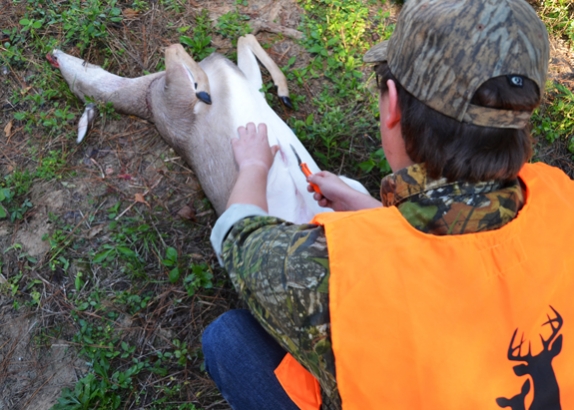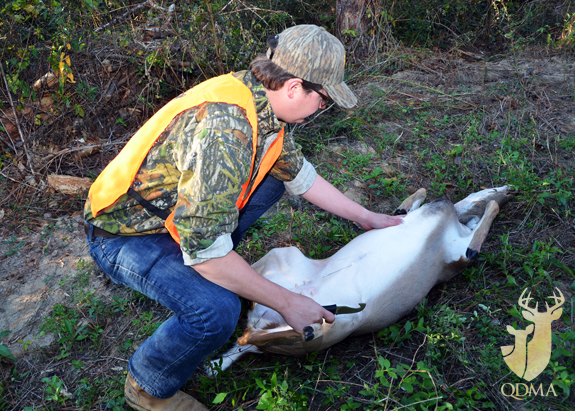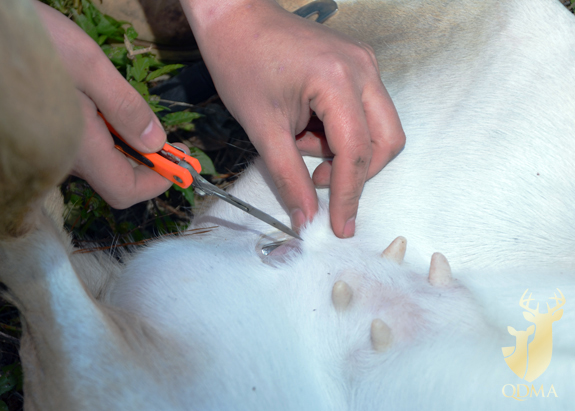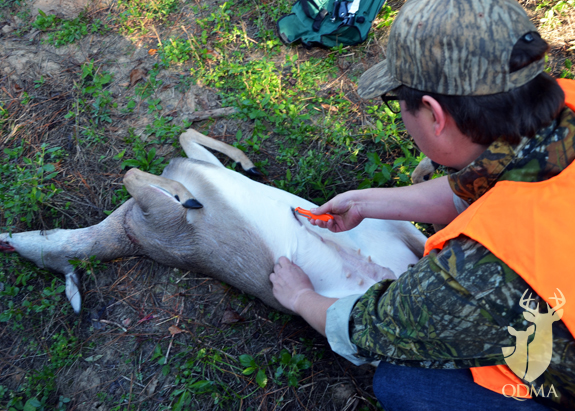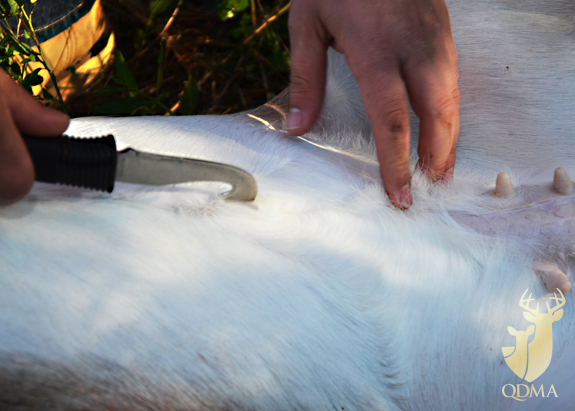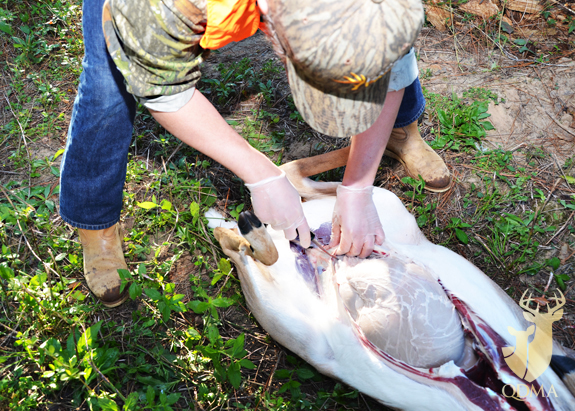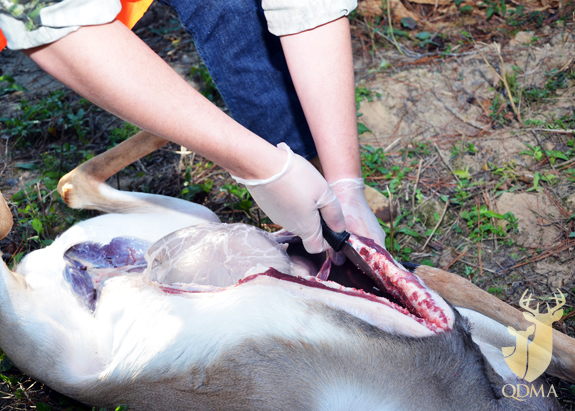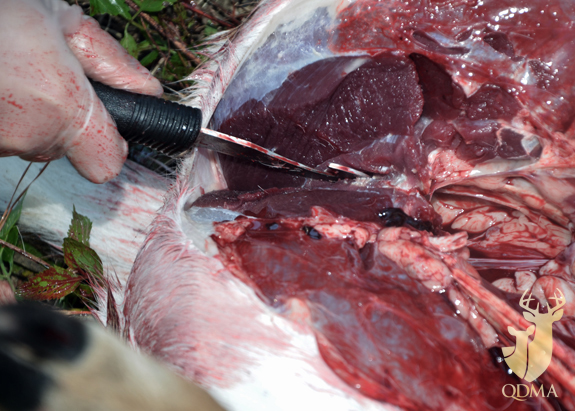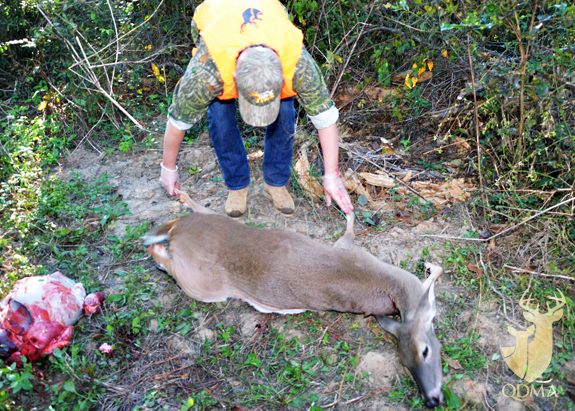Sportsmanship includes the responsible care and use of meat obtained while hunting. An important step toward placing quality venison on your dinner table is proper care of the animal immediately following harvest. To help with that endeavor, here is a step-by-step pictorial guide to field-dressing a white-tailed deer.
Some hunters have a meat pole or skinning shed where they hang their deer to remove the entrails. That’s great, but most hunters field-dress their deer on the ground prior to bringing them home or taking them to the meat processor. If you field-dress your deer while it’s hanging, you can still follow these directions – gravity simply helps the process. If you field-dress your deer on the ground, follow these 10 steps to make this important task quick and easy.
1) Start by tagging your deer, if required, and then put on a pair of rubber, plastic or latex gloves.
2) Place the deer on its back with its hind legs spread.
3) If it is a buck, remove the testicles, and use the hole left behind as your starting point. If it is a doe, like you see in these photos, start at the bottom of the udder.
4) Poke your knife into the skin and begin cutting up toward the chest. Keep the cut shallow and only cut through the skin. A deep cut will puncture the stomach and make your job messy and smelly. Cut from your starting point up to the sternum (bottom of rib cage).
If your knife has a guthook, pull from your starting point up to the sternum.A guthook can help guard against cutting into the stomach.
5) The lower half of the body cavity is now open and you can remove the entrails (stomach, intestines, etc.).
Pull everything out and cut the organs away from the body. The large intestine connects to the anus, and you will not be able to remove it in its entirety at this point. You can cut through the large intestine or move it aside until Step 9. If you choose to cut through it, be careful to not get any feces on the meat. You’ll remove the lower portion of the intestine and the bladder in Step 9.
6) You now have an empty lower cavity and you will be able to see the diaphragm. The diaphragm is simply the thin wall of muscle that separates the chest cavity (heart and lungs) from the lower cavity (stomach and intestines).
7) Remove the diaphragm by cutting along the inside of the ribs. You will now be able to see the heart and lungs.
Note: You will notice in these photos that the hunter has also cut through the sternum (brisket), using a saw or heavy knife, to reach the heart and lungs. Cutting through the sternum is not necessary to field-dress a deer, but it’s an option as long as you will NOT be mounting the deer. However, if you will be making a trip to the taxidermist’s, never cut through the sternum or anywhere in front of the front legs.
8) Reach into the upper chest cavity and remove the heart and lungs by cutting them away from the body. You will need to reach in and cut the esophagus to detach the lungs.
9) Return to your starting point between the legs and cut from there down through the meat to the anus. This will allow the back legs to lay open and will expose the pelvis.
Cut through the pelvis with a small saw or a pair of lopping/pruning shears. This will expose the bladder and lower portion of the large intestine. Cut these away with care to not spill urine or feces on the animal. The deer’s tenderloins are among the highest quality cuts of meat and they lie on the inside of the lower body cavity, close to the stomach and intestines. Spilling urine or feces on them can affect their quality.
10) Roll your deer over or pick its front end up to dump any blood out and you’re done. Take care to keep the carcass clean of dirt, leaves and other debris.
At this point you can take your deer home or to the meat processor’s. If possible, wash it out to remove any remaining blood or dirt. Congratulations, and enjoy your venison!
